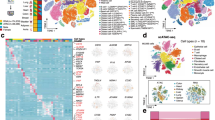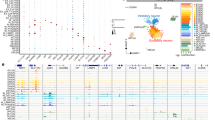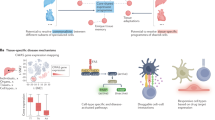Abstract
Studying tissue composition and function in non-human primates (NHPs) is crucial to understand the nature of our own species. Here we present a large-scale cell transcriptomic atlas that encompasses over 1 million cells from 45 tissues of the adult NHP Macaca fascicularis. This dataset provides a vast annotated resource to study a species phylogenetically close to humans. To demonstrate the utility of the atlas, we have reconstructed the cell–cell interaction networks that drive Wnt signalling across the body, mapped the distribution of receptors and co-receptors for viruses causing human infectious diseases, and intersected our data with human genetic disease orthologues to establish potential clinical associations. Our M. fascicularis cell atlas constitutes an essential reference for future studies in humans and NHPs.
This is a preview of subscription content, access via your institution
Access options
Access Nature and 54 other Nature Portfolio journals
Get Nature+, our best-value online-access subscription
$32.99 / 30 days
cancel any time
Subscribe to this journal
Receive 51 print issues and online access
$199.00 per year
only $3.90 per issue
Buy this article
- Purchase on SpringerLink
- Instant access to full article PDF
Prices may be subject to local taxes which are calculated during checkout





Similar content being viewed by others
Data availability
All raw data produced in this study (including NHPCA and mouse neocortex data) have been deposited to the CNGB Nucleotide Sequence Archive (accession code CNP0001469). All NHPCA count matrix data are available from https://db.cngb.org/nhpca/download. We have also provided the NHPCA website (https://db.cngb.org/nhpca/), an open and interactive database for exploration. The public datasets used in this study can be accessed as described below: the HCL count matrix is available at https://figshare.com/articles/dataset/HCL_DGE_Data/7235471, the MCA count matrix is available at https://figshare.com/articles/dataset/MCA_DGE_Data/5435866 and the count matrix for the Tabula Muris dataset is available at https://figshare.com/projects/Tabula_Muris_Transcriptomic_characterization_of_20_organs_and_tissues_from_Mus_musculus_at_single_cell_resolution/27733. The Gene Expression Omnibus (GEO) accession numbers for the two human kidney datasets are GSE121862 and GSE151302. The GEO accession number for the mouse kidney data is GSE107585. The GEO accession number for the human neocortex data is GSE97942. The human heart data can be accessed at the European Nucleotide Archive (https://www.ebi.ac.uk/ena/) using accession number ERP123138. The mouse heart data can be found through accession number E-MTAB-7869 in the database of the European Bioinformatics Institute (https://www.ebi.ac.uk/arrayexpress/experiments/E-MTAB-7869/). Summary statistics files for each human trait were downloaded from the UK Biobank database or published studies (data links in Supplementary Table 6a). Source data are provided with this paper.
Code availability
Computer code used for processing the snRNA-seq, scRNA-seq and scATAC-seq data is available at https://github.com/single-cell-BGI/NHPCA.
References
Rozenblatt-Rosen, O., Stubbington, M. J. T., Regev, A. & Teichmann, S. A. The Human Cell Atlas: from vision to reality. Nature 550, 451–453 (2017).
Carbone, L. et al. Gibbon genome and the fast karyotype evolution of small apes. Nature 513, 195–201 (2014).
Taylor, K. Clinical veterinarian’s perspective of non-human primate (NHP) use in drug safety studies. J. Immunotoxicol. 7, 114–119 (2010).
Zhu, L. et al. Single-cell sequencing of peripheral mononuclear cells reveals distinct immune response landscapes of COVID-19 and influenza patients. Immunity 53, 685–696 (2020).
Delorey, T. M. et al. COVID-19 tissue atlases reveal SARS-CoV-2 pathology and cellular targets. Nature 595, 107–113 (2021).
Ding, J. et al. Systematic comparison of single-cell and single-nucleus RNA-sequencing methods. Nat. Biotechnol. 38, 737–746 (2020).
Han, X. et al. Mapping the mouse cell atlas by Microwell-seq. Cell 172, 1091–1107 (2018).
Han, X. et al. Construction of a human cell landscape at single-cell level. Nature 581, 303–309 (2020).
Brazovskaja, A. et al. Cell atlas of the regenerating human liver after portal vein embolization. Preprint at bioRxiv https://doi.org/10.1101/2021.06.03.444016 (2021).
Bram, Y. et al. Cell and tissue therapy for the treatment of chronic liver disease. Annu. Rev. Biomed. Eng. 23, 517–546 (2021).
Krausgruber, T. et al. Structural cells are key regulators of organ-specific immune responses. Nature 583, 296–302 (2020).
Kalucka, J. et al. Single-cell transcriptome atlas of murine endothelial cells. Cell 180, 764–779 (2020).
Geirsdottir, L. et al. Cross-species single-cell analysis reveals divergence of the primate microglia program. Cell 179, 1609–1622 (2019).
Petrany, M. J. et al. Single-nucleus RNA-seq identifies transcriptional heterogeneity in multinucleated skeletal myofibers. Nat. Commun. 11, 6374 (2020).
Stål, P., Marklund, S., Thornell, L. E., De Paul, R. & Eriksson, P. O. Fibre composition of human intrinsic tongue muscles. Cells Tissues Organs 173, 147–161 (2003).
Vijay, J. et al. Single-cell analysis of human adipose tissue identifies depot- and disease-specific cell types. Nat. Metab. 2, 97–109 (2020).
Merrick, D. et al. Identification of a mesenchymal progenitor cell hierarchy in adipose tissue. Science 364, eaav2501 (2019).
Ribeiro, R. et al. Human periprostatic white adipose tissue is rich in stromal progenitor cells and a potential source of prostate tumor stroma. Exp. Biol. Med. 237, 1155–1162 (2012).
Schröder, K., Wandzioch, K., Helmcke, I. & Brandes, R. P. Nox4 acts as a switch between differentiation and proliferation in preadipocytes. Arter. Thromb. Vasc. Biol. 29, 239–245 (2009).
Ha, C. W. Y. et al. Translocation of viable gut microbiota to mesenteric adipose drives formation of creeping fat in humans. Cell 183, 666–683 (2020).
Adler, E., Mhawech-Fauceglia, P., Gayther, S. A. & Lawrenson, K. PAX8 expression in ovarian surface epithelial cells. Hum. Pathol. 46, 948–956 (2015).
Ng, A. et al. Lgr5 marks stem/progenitor cells in ovary and tubal epithelia. Nat. Cell Biol. 16, 745–757 (2014).
Parte, S. C., Batra, S. K. & Kakar, S. S. Characterization of stem cell and cancer stem cell populations in ovary and ovarian tumors. J. Ovarian Res. 11, 69 (2018).
Nusse, R. & Clevers, H. Wnt/β-catenin signaling, disease, and emerging therapeutic modalities. Cell 169, 985–999 (2017).
Leung, C., Tan, S. H. & Barker, N. Recent advances in Lgr5+ stem cell research. Trends Cell Biol. 28, 380–391 (2018).
Barker, N. & Clevers, H. Leucine-rich repeat-containing G-protein-coupled receptors as markers of adult stem cells. Gastroenterology 138, 1681–1696 (2010).
Lee, J.-H. et al. Anatomically and functionally distinct lung mesenchymal populations marked by Lgr5 and Lgr6. Cell 170, 1149–1163 (2017).
Huch, M. et al. In vitro expansion of single Lgr5+ liver stem cells induced by Wnt-driven regeneration. Nature 494, 247–250 (2013).
Barker, N. et al. Identification of stem cells in small intestine and colon by marker gene Lgr5. Nature 449, 1003–1007 (2007).
Lake, B. B. et al. A single-nucleus RNA-sequencing pipeline to decipher the molecular anatomy and pathophysiology of human kidneys. Nat. Commun. 10, 2832 (2019).
Muto, Y. et al. Single cell transcriptional and chromatin accessibility profiling redefine cellular heterogeneity in the adult human kidney. Nat. Commun. 12, 2190 (2021).
Tabula Muris Consortium. et al. Single-cell transcriptomics of 20 mouse organs creates a Tabula Muris. Nature 562, 367–372 (2018).
Park, J. et al. Single-cell transcriptomics of the mouse kidney reveals potential cellular targets of kidney disease. Science 360, 758–763 (2018).
Barker, N. et al. Lgr5+ve stem/progenitor cells contribute to nephron formation during kidney development. Cell Rep. 2, 540–552 (2012).
Lake, B. B. et al. Integrative single-cell analysis of transcriptional and epigenetic states in the human adult brain. Nat. Biotechnol. 36, 70–80 (2018).
Nakashima, H. et al. R-spondin 2 promotes acetylcholine receptor clustering at the neuromuscular junction via Lgr5. Sci. Rep. 6, 28512 (2016).
Leung, C. et al. Lgr5 marks adult progenitor cells contributing to skeletal muscle regeneration and sarcoma formation. Cell Rep. 33, 108535 (2020).
Litvinukova, M. et al. Cells of the adult human heart. Nature 588, 466–472 (2020).
Vidal, R. et al. Transcriptional heterogeneity of fibroblasts is a hallmark of the aging heart. JCI Insight 4, e131092 (2019).
Vankelecom, H. Non-hormonal cell types in the pituitary candidating for stem cell. Semin. Cell Dev. Biol. 18, 559–570 (2007).
Klein, D. et al. Wnt2 acts as a cell type-specific, autocrine growth factor in rat hepatic sinusoidal endothelial cells cross-stimulating the VEGF pathway. Hepatology 47, 1018–1031 (2008).
Nusse, R. Wnt signaling and stem cell control. Cell Res. 18, 523–527 (2008).
Niehrs, C. The complex world of WNT receptor signalling. Nat. Rev. Mol. Cell Biol. 13, 767–779 (2012).
Zhang, M. et al. β-catenin safeguards the ground state of mouse pluripotency by strengthening the robustness of the transcriptional apparatus. Sci. Adv. 6, eaba1593 (2020).
Devakumar, D. et al. Infectious causes of microcephaly: epidemiology, pathogenesis, diagnosis, and management. Lancet Infect. Dis. 18, e1–e13 (2018).
Zhu, N. et al. A novel coronavirus from patients with pneumonia in China, 2019. N. Engl. J. Med. 382, 727–733 (2020).
Hoffmann, M. et al. SARS-CoV-2 cell entry depends on ACE2 and TMPRSS2 and is blocked by a clinically proven protease inhibitor. Cell 181, 271–280 (2020).
Rockx, B. et al. Comparative pathogenesis of COVID-19, MERS, and SARS in a nonhuman primate model. Science 368, 1012–1015 (2020).
Diao, B. et al. Human kidney is a target for novel severe acute respiratory syndrome coronavirus 2 infection. Nat. Commun. 12, 2506 (2021).
Muus, C. et al. Single-cell meta-analysis of SARS-CoV-2 entry genes across tissues and demographics. Nat. Med. 27, 546–559 (2021).
Sungnak, W. et al. SARS-CoV-2 entry factors are highly expressed in nasal epithelial cells together with innate immune genes. Nat. Med. 26, 681–687 (2020).
Ying, M. et al. COVID-19 with acute cholecystitis: a case report. BMC Infect. Dis. 20, 437 (2020).
Tosi, M. F. Innate immune responses to infection. J. Allergy Clin. Immunol. 116, 241–249 (2005).
Bell, L. C. K. et al. Transcriptional response modules characterize IL-1β and IL-6 activity in COVID-19. iScience 24, 101896 (2021).
Nie, X. et al. Multi-organ proteomic landscape of COVID-19 autopsies. Cell 184, 775–791 (2021).
Gate, D. et al. Clonally expanded CD8 T cells patrol the cerebrospinal fluid in Alzheimer’s disease. Nature 577, 399–404 (2020).
Zhong, J., Yang, H. & Kon, V. Kidney as modulator and target of "good/bad" HDL. Pediatr. Nephrol. 34, 1683–1695 (2019).
Athanasiadou, A. et al. Early motor signs of attention-deficit hyperactivity disorder: a systematic review. Eur. Child Adolesc. Psychiatry 29, 903–916 (2020).
Amino, T. et al. Redefining the disease locus of 16q22.1-linked autosomal dominant cerebellar ataxia. J. Hum. Genet. 52, 643–649 (2007).
Tse, K. H. & Herrup, K. DNA damage in the oligodendrocyte lineage and its role in brain aging. Mech. Ageing Dev. 161, 37–50 (2017).
Wang, S. et al. Single-cell transcriptomic atlas of primate ovarian aging. Cell 180, 585–600 (2020).
Villiger, P. M. et al. Tocilizumab for induction and maintenance of remission in giant cell arteritis: a phase 2, randomised, double-blind, placebo-controlled trial. Lancet 387, 1921–1927 (2016).
Le Stang, M.-B., Desenclos, J., Flamant, M., Chousterman, B. G. & Tabibzadeh, N. The good treatment, the bad virus, and the ugly inflammation: pathophysiology of kidney involvement during COVID-19. Front. Physiol. 12, 209 (2021).
Cavalcanti, A. B. et al. Hydroxychloroquine with or without azithromycin in mild-to-moderate Covid-19. N. Engl. J. Med. 383, 2041–2052 (2020).
Verghese, D., Alrifai, T., Nimmagadda, M. & Upadhyay, M. It could be in the kidneys: fibromuscular dysplasia and the association with headaches and mood disorders. BMJ Case Rep. 12, e231322 (2019).
Chavali, M. et al. Wnt-dependent oligodendroglial–endothelial interactions regulate white matter vascularization and attenuate injury. Neuron 108, 1130–1145 (2020).
Heallen, T. et al. Hippo pathway inhibits Wnt signaling to restrain cardiomyocyte proliferation and heart size. Science 332, 458–461 (2011).
Osmundsen, A. M., Keisler, J. L., Taketo, M. M. & Davis, S. W. Canonical WNT signaling regulates the pituitary organizer and pituitary gland formation. Endocrinology 158, 3339–3353 (2017).
Bakken, T. E. et al. Single-nucleus and single-cell transcriptomes compared in matched cortical cell types. PLoS ONE 13, e0209648 (2018).
Yu, Y. et al. Single-nucleus chromatin accessibility landscape reveals diversity in regulatory regions across distinct adult rat cortex. Front. Mol. Neurosci. 14, 651355 (2021).
Dobin, A. et al. STAR: ultrafast universal RNA-seq aligner. Bioinformatics 29, 15–21 (2013).
Tarasov, A., Vilella, A. J., Cuppen, E., Nijman, I. J. & Prins, P. Sambamba: fast processing of NGS alignment formats. Bioinformatics 31, 2032–2034 (2015).
Del-Aguila, J. L. et al. A single-nuclei RNA sequencing study of Mendelian and sporadic AD in the human brain. Alzheimers Res. Ther. 11, 71 (2019).
Young, M. D. & Behjati, S. SoupX removes ambient RNA contamination from droplet-based single-cell RNA sequencing data. Gigascience 9, giaa151 (2020).
McGinnis, C. S., Murrow, L. M. & Gartner, Z. J. DoubletFinder: doublet detection in single-cell RNA sequencing data using artificial nearest neighbors. Cell Syst. 8, 329–337 (2019).
Wolf, F. A., Angerer, P. & Theis, F. J. SCANPY: large-scale single-cell gene expression data analysis. Genome Biol. 19, 15 (2018).
Hao, Y. et al. Integrated analysis of multimodal single-cell data. Cell 184, 3573–3587 (2021).
Yu, G., Wang, L. G. & He, Q. Y. ChIPseeker: an R/Bioconductor package for ChIP peak annotation, comparison and visualization. Bioinformatics 31, 2382–2383 (2015).
Yates, A. D. et al. Ensembl 2020. Nucleic Acids Res. 48, D682–D688 (2020).
Qiu, X. et al. Reversed graph embedding resolves complex single-cell trajectories. Nat. Methods 14, 979–982 (2017).
Efremova, M., Vento-Tormo, M., Teichmann, S. A. & Vento-Tormo, R. CellPhoneDB: inferring cell–cell communication from combined expression of multi-subunit ligand–receptor complexes. Nat. Protoc. 15, 1484–1506 (2020).
Bryois, J. et al. Genetic identification of cell types underlying brain complex traits yields insights into the etiology of Parkinson’s disease. Nat. Genet. 52, 482–493 (2020).
Granja, J. M. et al. ArchR is a scalable software package for integrative single-cell chromatin accessibility analysis. Nat. Genet. 53, 403–411 (2021).
Shen, W., Le, S., Li, Y. & Hu, F. SeqKit: a cross-platform and ultrafast toolkit for FASTA/Q file manipulation. PLoS ONE 11, e0163962 (2016).
Acknowledgements
We thank W. Liu and L. Xu from the Huazhen Laboratory Animal Breeding Centre for helping in the collection of monkey tissues, D. Zhu and H. Li from the Bioland Laboratory (Guangzhou Regenerative Medicine and Health Guangdong Laboratory) for technical help, G. Guo and H. Sun from Zhejiang University for providing HCL and MCA gene expression data matrices, G. Dong and C. Liu from BGI Research, and X. Zhang, P. Li and C. Qi from the Guangzhou Institutes of Biomedicine and Health for experimental advice or providing reagents. This work was supported by the Shenzhen Basic Research Project for Excellent Young Scholars (RCYX20200714114644191), Shenzhen Key Laboratory of Single-Cell Omics (ZDSYS20190902093613831), Shenzhen Bay Laboratory (SZBL2019062801012) and Guangdong Provincial Key Laboratory of Genome Read and Write (2017B030301011). In addition, L.L. was supported by the National Natural Science Foundation of China (31900466), Y. Hou was supported by the Natural Science Foundation of Guangdong Province (2018A030313379) and M.A.E. was supported by a Changbai Mountain Scholar award (419020201252), the Strategic Priority Research Program of the Chinese Academy of Sciences (XDA16030502), a Chinese Academy of Sciences–Japan Society for the Promotion of Science joint research project (GJHZ2093), the National Natural Science Foundation of China (92068106, U20A2015) and the Guangdong Basic and Applied Basic Research Foundation (2021B1515120075). M.L. was supported by the National Key Research and Development Program of China (2021YFC2600200).
Author information
Authors and Affiliations
Contributions
L.H., Y. Hou, X.X., M.A.E. and L.L. conceived the idea; Y. Hou, X.X., M.A.E. and L.L. supervised the work; L.H., Xiaoyu Wei, Y. Yuan, M.A.E. and L.L. designed the experiments; L.H., Xiaoyu Wei, G.V., Y. Yuan, X. Zhang, P.F., P.G., Xingyuan Liu, F.Y., S.S., G.L., J.A., Y. Lei, Y. Lai, M.C., C.-W. Wong, X.G., S.L. and J.M. collected tissue samples; C.L., G.V., Zhifeng Wang, Y. Yuan, X. Zhang, P.F., Q.D., Ya Liu, Y. Huang, H.L., B.W., M.C., J.X., M.W., C. Wang, Y.Z., Y. Yu, H. Zheng, Y.W. and S.X. performed the experiments. L.H., Xiaoyu Wei, G.V., Z. Zhuang, X. Zou, T.P., Y. Lai, L.W., Q. Shi, H. Yu, Yang Liu, D.X., F.H., Z. Zhu and C. Ward performed data analysis. L.H., Xiaoyu Wei, C.L., G.V., Z. Zhuang, X. Zou, Z. Wang, T.P., Y. Yang, J.L. and L.L. prepared the figures. H. Yu, Xiaofeng Wei, F.C., T.Y., W.D. and J.C. prepared the website. Zongren Wang, Z.P., C.-W.W., B.Q., A.S., J.I., L.F., Yan Liu, Z.L., Xiaolei Liu, H. Zhang, M.L., Q. Sun, P.H.M., N.B., P.M.-C., Y.G., J.M., M.U., T.T., S.L., H. Yang and J.W. provided relevant advice and reviewed the manuscript. L.H., G.V., M.A.E. and L.L. wrote the manuscript with input from all authors. All other authors contributed to the work. All authors read and approved the manuscript for submission.
Corresponding authors
Ethics declarations
Competing interests
Employees of BGI have stock holdings in BGI. All other authors declare no competing interests.
Peer review
Peer review information
Nature thanks Benjamin Humphreys, Itai Yanai and the other, anonymous, reviewer(s) for their contribution to the peer review of this work. Peer reviewer reports are available.
Additional information
Publisher’s note Springer Nature remains neutral with regard to jurisdictional claims in published maps and institutional affiliations.
Supplementary information
Supplementary Information
This file contains the Supplementary Note, the legends for Supplementary Figs. 1–46 and the legends for Supplementary Tables 1–6.
Supplementary Table 1
Description of all profiled monkey tissues, cell types and markers used for cluster annotation.
Supplementary Table 2
Global analysis of monkey common cell types and tissue-specific signatures.
Supplementary Table 3
Global distribution of LGR5, LGR6 and MKI67 expression in monkey tissues.
Supplementary Table 4
Species-specific genes in kidney DCTCs between monkey, human and mouse.
Supplementary Table 5
Expression of virus receptors, ACE2 and TMPRSS2 in monkey tissues.
Supplementary Table 6
Association of GWAS traits and human genetic diseases with monkey cell types.
Rights and permissions
About this article
Cite this article
Han, L., Wei, X., Liu, C. et al. Cell transcriptomic atlas of the non-human primate Macaca fascicularis. Nature 604, 723–731 (2022). https://doi.org/10.1038/s41586-022-04587-3
Received:
Accepted:
Published:
Issue date:
DOI: https://doi.org/10.1038/s41586-022-04587-3
This article is cited by
-
Single-cell atlas in the living fossil Yangtze sturgeon provides insight into the evolution of fish
Genome Biology (2025)
-
Regional and aging-specific cellular architecture of non-human primate brains
Genome Medicine (2025)
-
Single-cell RNA sequencing dataset of hearts from wild type and Cyp26b1 knockout mouse embryos
Scientific Data (2025)
-
Microenvironmental determinants of endothelial cell heterogeneity
Nature Reviews Molecular Cell Biology (2025)
-
In vivo self-renewal and expansion of quiescent stem cells from a non-human primate
Nature Communications (2025)



